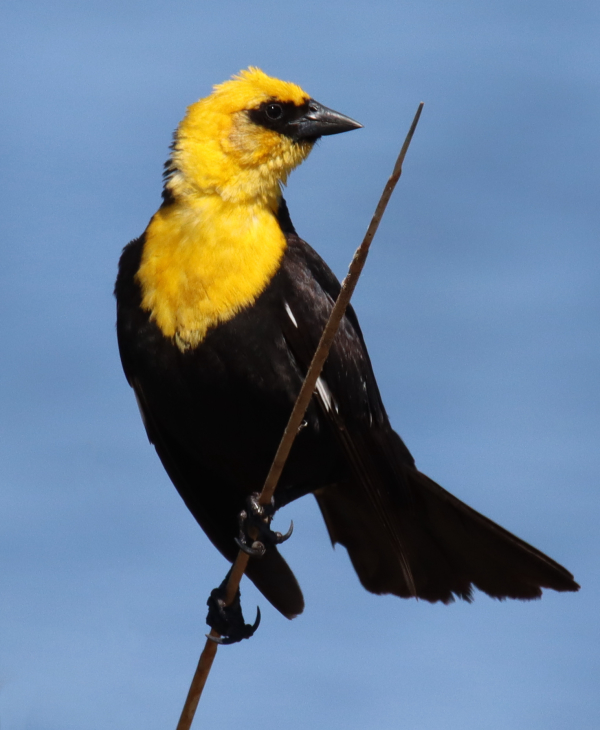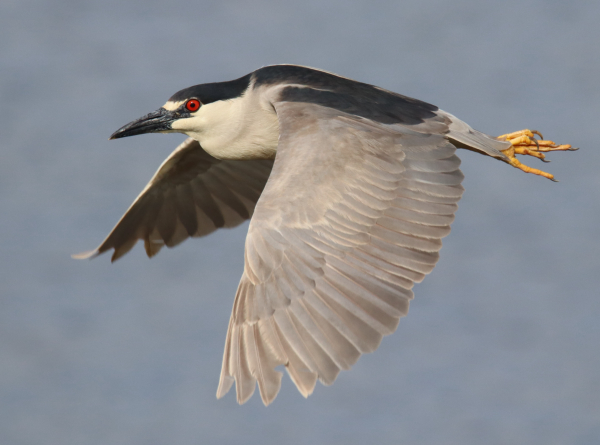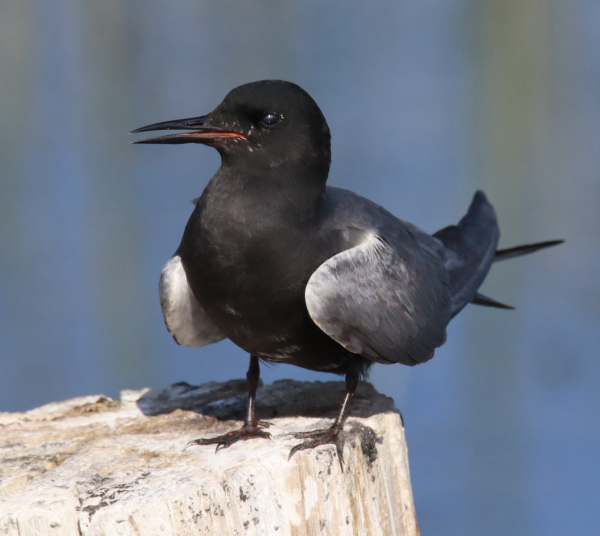

Area wetlands abound with a variety of birds to study and photograph, ranging from Yellow-headed Blackbirds (top) to Black-crowned Night Herons (above) to Black Terns (below).

|
It was only my second hummingbird sighting ever in the Missouri River watershed, decades after my first, and it was most unexpected as Vicki and I took a break along a riverside hiking trail on the southwest side of Bismarck. I guess I was pretty excited as I announced and pointed to the fast-moving Ruby-throat as it darted every which way to catch tiny insects in the air and on tall plants from a distance. But it soon began moving in our direction and we a minute to follow the female’s activities after a tranquil rest stop amid songs of Baltimore Orioles, Brown Thrashers, and Song Sparrows.
The Missouri River walk was actually the second of our late afternoon hikes; the first being along the edge of a high plateau where the open prairie met the Missouri River. An early attraction was an American Kestrel that was actively hunting, using an updraft along a high riverside cliff to hold a pretty stationary position during its hunt. Occasionally the little male hovered, then dived toward would be prey, putting on a pretty exciting show for Vicki to enjoy through binoculars. Bobolinks were the other stars of the show during the Double Ditch hike, and I was sharing how much I enjoy their display flights and calls, when on cue one of the males provided a beautiful illustration of the display.
Half of the 4 nest boxes that were installed in the open grassland were occupied by Tree Swallows, and a Western Meadowlark seemed to lead us down the path at one point, which Vicki perceived as trying to lead us away from a nest site – good call Vicki. At first it was making loud contact calls, but then it took a little hop of a flight and voiced a full-on meadowlark song. Before we settled on walking through Double Ditch we checked out the potential of hiking the big buttes a few miles north of there. As we contemplated where to begin the hike, an isolated rainstorm began to sprinkle on the windshield, which made us press onward to Double Ditch. But not before we observed many Black-billed Magpies in the area, and several Turkey Vultures perched on sandstone outcrops atop 2 of the steep buttes. This is a traditional vulture nesting area, where they utilize cave-like crevices in the wind-eroded sandstone.
We also spied the head of a colorful Ring-necked Pheasant poke above the tall green grass next to the road, then noticed a female it was following. We marveled at how green everything was, truly as green as it gets, casting a beauty across the tall prairie hills and riverine woodlands that can’t be beat any other time of the year. Just as we were about to look for a drier hiking area, I spied a special bird to share with Vicki – a male Orchard Oriole was singing atop a prominent bush, and we saw the female slip in and out of the thicker foliage below it. As we redirected southward toward Double Ditch, a Turkey Vulture glided in sleek aerodynamic fashion not far beyond the windshield, followed by another in a quick angled glide. Farther down River Road, we saw a small flock of Wild Turkeys with a gobbler fanning its tail half-heartedly.
Earlier that day, after an hour’s drive across the Missouri Coteau and Missouri Slope geologic regions, I followed the east side of the Missouri River north to the capitol city, where on the edge of Bismarck a Swainson’s Hawk literally led me to Vicki’s house. It was only the second Swainson’s Hawk I saw that day, a species that has been obviously sparse across the region this spring. However, there were more Red-tailed Hawks than I usually see during this time of year; 3 were in the open plains and 3 more were in open areas near the riverbottom. I was also watching for Chestnut-collared Longspurs and other western songbirds along the drier areas of the Missouri Slope, but none showed Thursday.
Throughout the week, when the sun was right, I spent a few hours photographing next to the blooming chokecherries. My primary focus became photographing Yellow Warblers among the abundance of chokecherry blooms, which was a pleasing endeavor, a continuation of the songbird photography that I have been immersed in for more than a month. It was probably my last warbler photo hurrah of spring, and I share the photos from those outings in this week’s Bird Photography feature at the end of this issue. The only other birds to frequent the chokecherry stand were Least Flycatchers and Eastern Kingbirds, although a few Orchard Orioles were still active among the adjacent plum trees.
Closer to Home
Last Wednesday, I saw an adult Bald Eagle soaring about 4 miles south of my office, and 2 miles closer I observed a male Northern Harrier for the second time that week. This time, as it was harried by Red-winged Blackbirds and Black Terns, the silver Northern Harrier dropped unceremoniously to the ground, and after moments of winged tormentors diving at the hawk, it took flight again, this time with mammalian prey in its talons.
Earlier that day, my bay window view was graced with a young female Baltimore Oriole that was obviously molting but already showed a black head and back. I would have thought it was a young male, but the top of the tail feathers are the telltale thing to look for when distinguishing young males from females – a male will have black tail feathers, but a female will not. That said, I have 2 other female Baltimore Orioles coming to my 3 grape jelly feeders along with at least 1 adult male, maybe more; hopefully more.
Sunday, although there is at least 1 adult male Orchard Oriole and at least 2 yearling male Orchards grabbing some jelly periodically, I realized no female Orchards were coming to the feeders, which may have been the case for a day or 2 by that time, and it’s been the case ever since. Before, there were 2 and probably 3 female Orchard Orioles coming to feed, so what’s happening? My initial thought was that perhaps they are incubating a clutch of eggs in a new nest – hope so!
There was another Sunday breakthrough too: Seeing the first-ever Cedar Waxwing hanging low from the hanger on my #2 oriole feeder eating grape jelly! Hope it keeps coming back and attracts other waxwings to my feeding station too. The previous Wednesday my bay window view was graced with a Cedar Waxwing that seemed interested in my feeding station, but it appeared to be put off by all the other birds’ activities at that moment. The same afternoon a male Yellow Warbler perched on an adjacent sumac too, and while I had a Yellow Warbler feeding on grape jelly during migration, this one didn’t visit a feeder, nor has it apparently returned – it was probably just on the way to grab bugs from my blooming chokecherries.
Then, to top off the week, after returning from a photo drive Monday evening, as I walked toward the front door I heard a vibrant call that I am very familiar with, but that I’ve never heard in my yard before. I looked up and flying above my house was a pair of Marbled Godwits – a new yard species! Hope you have some fun surprises at home and far afield – it’s that time of the year, and let’s all savor these beautiful June days as we the first official day of summer approaches next week.
Article and photos by Paul Konrad
Share your bird sightings and photographs at editorstbw2@gmail.com